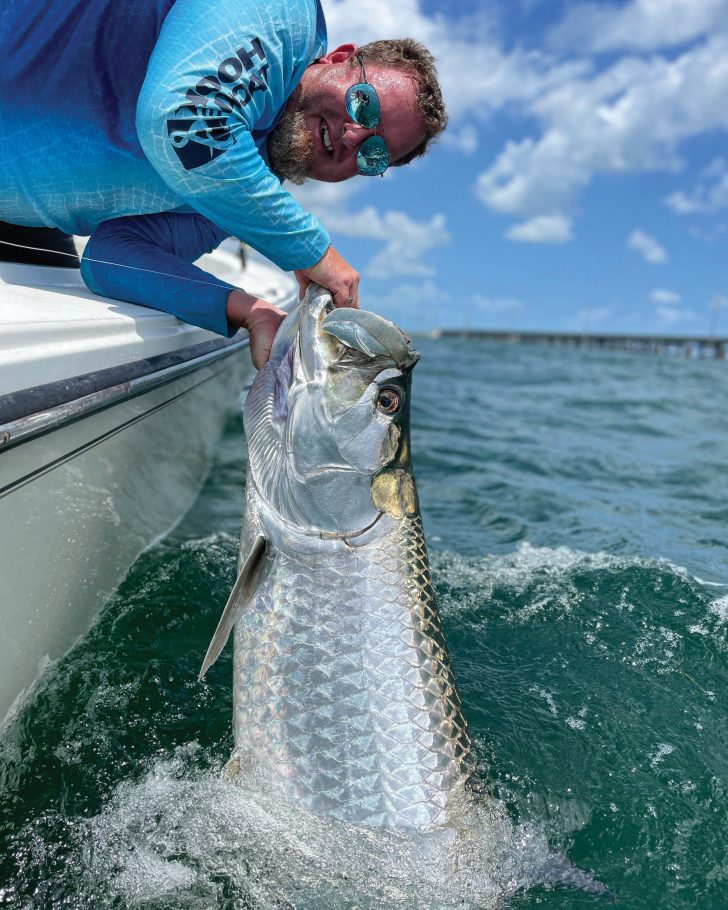by: Capt. Billy Norris
Tarpon are one of the most sought after gamefish in the world. Drag screaming runs combined with aerial acrobatics make them a challenging fight for even the most skilled anglers. Whether its stalking them on shallow grass flats, chasing schools down the white sugar sand beaches, or targeting fish in current swept passes, tarpon fishing is one of the most addictive types of fishing Florida has to offer. In this article I will go over a few tips and tricks to help you improve your abilities when attempting to best the silver king.


Tarpon can be extremely picky when it comes to both baits and rigs. Fluorocarbon is an absolute must when it comes to your leaders. Depending on the water quality, you may have to switch pound test if the fish are leader shy. 7 feet of 80-pound YoZuri pink fluorocarbon is where I typically start but will bump down to 50 pound if the water is very clear. Everyone has their own preference of hooks, but I prefer either 8/0 Owner SSW Circles, or 6/0 Mustad UltraPoint Demon Circle hooks.
Believe it or not, tarpon will pretty much eat anything that lives in the ocean. I have caught them on cut bait, threadfins, crabs, pilchards, pinfish, discarded fish carcasses…literally almost everything. However, this does not mean that you can just use anything. Although they will consume a variety of baits, they are extremely picky and are notorious for getting dialed in on one specific type of prey. For example, when I’m fishing for tarpon in Marathon, I target two passes, Bahia Honda and the 7-Mile Bridge. Both passes are right next to each other, but at Bahia Honda the fish will only eat crabs and at 7-Mile they want mullet. It doesn’t seem to make any sense why two different schools so close to one another won’t eat the same things, but it is reality. Even the size of crabs that the fish will eat changes daily. Some days they will want small crabs, and other days larger ones. Crabs can be caught, but if you are purchasing them the cost can add up quickly. On average they retail for about $4-5 apiece, and on a day long tarpon trip I like to have at least 40 crabs of varying sizes. A good rule of thumb is you want crabs that are approximately the same width (across the carapace) as three of your fingers. Whether I’m using crabs, mullet, threadfins, etc., I will almost always freeline the bait, with the exception of sometimes using a cork to suspend the bait if needed. Being successful at hooking up tarpon comes from time put in on the water daily to figure out what they are eating at that particular time.
Now your gear and equipment are ready, you’re livewell is loaded with bait, and it’s time to get hooked up! The most crucial part of landing tarpon is understanding how to fight them. They are notorious for throwing the hook when they make their world-famous jumps. You will consistently hear guides refer to “flying” x amount of tarpon. For example, when talking about the day of fishing you will hear me say something like “flew 5 landed 2”. This means that we hooked up with five fish but only got two boatside.
Only landing a small percentage of hooked fish is not uncommon, but the more practice you get the more you will land. Finally, you have to bow. Everyone who has even a slight bit of familiarity with tarpon has heard the old expression “bow to the king”. That means when the fish jumps, drop your rod tip. I actually tell my customers to stab the tip of the rod quickly into the water when they first see the fish rise to jump. This action puts slack in the line and will reduce breakoffs or the hook being pulled.
Tarpon fishing is without a doubt one of the most challenging and addictive type of fishing in the world. Hopefully this article helped to answer some of your questions surrounding the silver king, and will help you to get out on the water and start landing some tarpon!
Captain Billy Norris is owner and operator of Pale Horse Fishing Charters in Bonita Springs, Florida. He guides the Southwest Florida area, and also operates tarpon charters out of Marathon in the Florida Keys during the month of May. You can contact him at (239)285-7710, or visit his website at http://www.PaleHorseFishingCharters.com.
